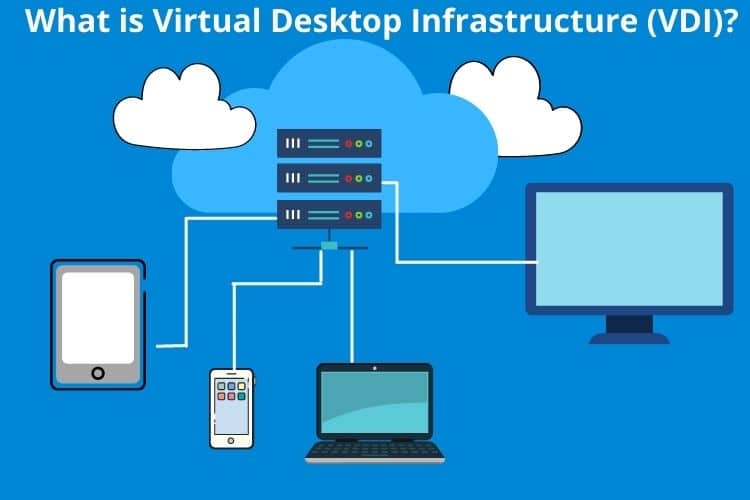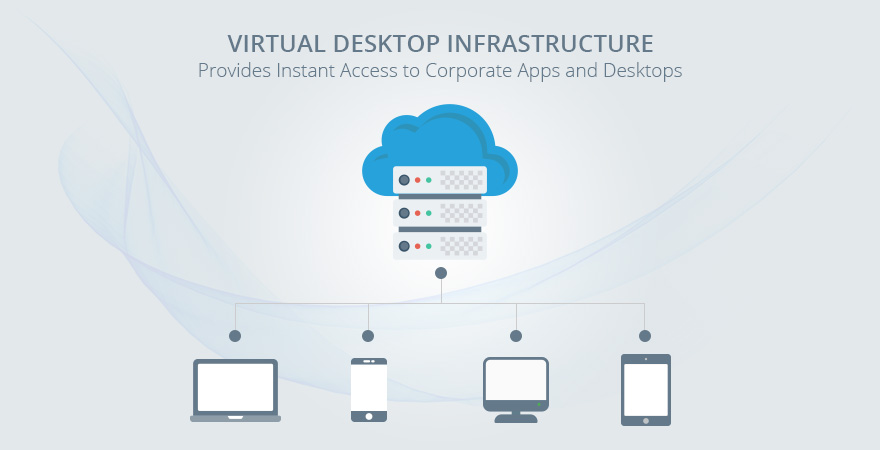What is Cloud-based Virtual Desktop Infrastructure (VDI)?
Cloud-based Virtual Desktop Infrastructure (VDI) is a revolutionary technology that enables organizations to access virtual desktops and applications from any device and location. By utilizing cloud services, VDI centralizes and manages desktop environments, offering enhanced security, scalability, and cost savings compared to traditional desktop infrastructure. This approach allows businesses to improve productivity and flexibility, as employees can securely access their desktops and applications from various devices, including smartphones, tablets, and laptops.
In a Cloud-based VDI environment, virtual machines (VMs) are created and hosted on remote servers, which users can access through a web browser or a remote desktop client. The VMs run a desktop operating system, such as Windows or Linux, and can be configured with custom applications and settings. This setup ensures that sensitive data remains secure on the server, reducing the risk of data breaches and unauthorized access.
Cloud-based VDI offers several benefits to organizations, including reduced capital and operational expenses, simplified desktop management, and increased security. By leveraging the power of cloud computing, businesses can scale their VDI environments up or down based on demand, ensuring optimal performance and resource utilization. Additionally, VDI enables organizations to provide remote and flexible work arrangements, empowering employees to work from home or while traveling, thereby improving work-life balance and job satisfaction.

Key Components of a Robust Cloud-based VDI Solution
Cloud-based virtual desktop infrastructure (VDI) is a powerful technology that relies on several essential components to deliver seamless and secure virtual desktop experiences. By understanding these components, organizations can make informed decisions when selecting a Cloud-based VDI solution and service provider. The primary components of a robust Cloud-based VDI solution include virtualization technologies, connection brokers, and storage systems.
Virtualization Technologies
Virtualization technologies are the foundation of any Cloud-based VDI solution. They enable the creation and management of multiple virtual machines (VMs) on a single physical server. Popular virtualization platforms include VMware vSphere, Microsoft Hyper-V, and Citrix Hypervisor. These platforms provide features like resource allocation, live migration, and high availability, ensuring optimal performance and reliability for virtual desktops and applications.
Connection Brokers
Connection brokers serve as the gateway to Cloud-based VDI environments, managing user connections to virtual desktops and applications. They facilitate automatic load balancing, ensuring that resources are utilized efficiently and that users experience consistent performance. Connection brokers also handle authentication, authorization, and access control, ensuring that only authorized users can access specific virtual desktops and applications. Examples of connection brokers include VMware Horizon, Citrix Virtual Apps and Desktops, and Microsoft Remote Desktop Services.
Storage Systems
Storage systems play a critical role in Cloud-based VDI environments, as they store and manage virtual desktop images, user data, and application data. High-performance storage solutions, such as solid-state drives (SSDs) and non-volatile memory express (NVMe), are essential for delivering fast and responsive virtual desktop experiences. Additionally, storage systems must provide features like data deduplication, compression, and snapshots to minimize storage requirements and simplify desktop image management.
Selecting the Right Service Provider
Choosing the right Cloud-based VDI service provider is crucial for ensuring seamless integration, support, and long-term success. Organizations should consider factors like the provider’s reputation, experience, and expertise in VDI environments. They should also evaluate the provider’s infrastructure, including their network, security, and compliance certifications. By selecting a reliable and experienced service provider, organizations can minimize the risk of downtime, data loss, and security breaches, ensuring a positive user experience for their virtual desktop infrastructure.
How to Implement a Successful Cloud-based VDI Project
Implementing a Cloud-based virtual desktop infrastructure (VDI) project requires careful planning, assessment, deployment, and management. By following a structured approach and considering best practices, organizations can ensure a smooth transition to a modern and flexible computing environment. This step-by-step guide covers the essential phases of implementing a Cloud-based VDI project, including potential challenges and best practices to consider during the implementation process.
Assessment Phase
The assessment phase involves evaluating the organization’s current desktop infrastructure, identifying pain points, and determining the requirements for a Cloud-based VDI solution. Key considerations during this phase include:
- User needs and expectations: Understanding user requirements is crucial for selecting the right VDI solution and ensuring a positive user experience.
- Application compatibility: Assessing the compatibility of existing applications with Cloud-based VDI environments is essential for minimizing disruptions and ensuring seamless transitions.
- Network infrastructure: Evaluating the organization’s network infrastructure, including bandwidth, latency, and security, is necessary for delivering high-performance virtual desktop experiences.
- Storage requirements: Estimating the storage requirements for virtual desktop images, user data, and application data is critical for selecting the appropriate storage solution.
Planning Phase
During the planning phase, organizations should define the architecture, infrastructure, and policies for their Cloud-based VDI solution. Key considerations include:
- Virtualization platform: Selecting a virtualization platform based on factors like scalability, performance, and cost is essential for ensuring a robust and reliable VDI environment.
- Connection broker: Choosing a connection broker that meets the organization’s needs for load balancing, authentication, and access control is crucial for delivering a seamless user experience.
- Storage solution: Selecting a high-performance storage solution that provides features like data deduplication, compression, and snapshots is necessary for minimizing storage requirements and simplifying desktop image management.
- Security policies: Implementing security policies, including multi-factor authentication, data encryption, and access controls, is essential for protecting the VDI environment from cyber threats.
Deployment Phase
The deployment phase involves configuring and deploying the Cloud-based VDI solution based on the planning and design. Key considerations include:
- Image management: Creating and managing virtual desktop images, including golden images and clones, is critical for ensuring consistent and standardized desktop environments.
- User environment setup: Configuring user profiles, settings, and data redirection is necessary for delivering personalized and familiar desktop experiences.
- Performance optimization: Tuning the VDI environment, including network, storage, and virtualization settings, is essential for delivering high-performance virtual desktop experiences.
- Testing and validation: Thoroughly testing and validating the VDI environment, including applications, network, and security, is necessary for ensuring a smooth and successful deployment.
Management Phase
The management phase involves ongoing monitoring, maintenance, and optimization of the Cloud-based VDI environment. Key considerations include:
- Monitoring and alerting: Implementing monitoring and alerting mechanisms for performance, availability, and security is essential for ensuring a reliable and secure VDI environment.
- Backup and disaster recovery: Implementing backup and disaster recovery strategies, including regular backups and offsite replication, is necessary for protecting against data loss and downtime.
- User support: Providing user support, including training, documentation, and troubleshooting, is essential for ensuring a positive user experience and maximizing productivity.
- Continuous improvement: Regularly reviewing and improving the VDI environment, including performance optimization, security updates, and feature enhancements, is necessary for maintaining a modern and flexible computing environment.
By following this step-by-step guide and considering best practices, organizations can successfully implement a Cloud-based VDI project, improving productivity, flexibility, and security while minimizing costs and complexity.

Top Cloud-based VDI Solutions in the Market
Cloud-based virtual desktop infrastructure (VDI) solutions have gained significant popularity in modern computing environments, enabling organizations to access virtual desktops and applications from any device and location, improving productivity and flexibility. With a variety of Cloud-based VDI solutions available today, selecting the right one can be challenging. Here are some of the leading Cloud-based VDI solutions in the market, along with their features, pricing, and performance.
Amazon WorkSpaces
Amazon WorkSpaces is a fully managed Desktop-as-a-Service (DaaS) solution that enables organizations to deploy virtual desktops in minutes. With Amazon WorkSpaces, users can access their desktops from any device, including Windows, Mac, Chrome OS, and Linux, as well as Android and iOS tablets and smartphones. Amazon WorkSpaces offers a range of bundles with different performance levels, starting at $6 per user per month.
Microsoft Windows Virtual Desktop
Microsoft Windows Virtual Desktop is a Cloud-based VDI solution that enables organizations to deploy virtual desktops and applications on Azure. With Windows Virtual Desktop, users can access their desktops and applications from any device, including Windows, Mac, Linux, and mobile devices. Windows Virtual Desktop offers a range of performance levels, starting at $10 per user per month.
VMware Horizon Cloud
VMware Horizon Cloud is a Cloud-based VDI solution that enables organizations to deploy virtual desktops and applications on multiple Cloud platforms, including VMware Cloud on AWS, Microsoft Azure, and IBM Cloud. With Horizon Cloud, users can access their desktops and applications from any device, including Windows, Mac, Linux, and mobile devices. Horizon Cloud offers a range of performance levels, starting at $16 per user per month.
Citrix Virtual Apps and Desktops
Citrix Virtual Apps and Desktops is a Cloud-based VDI solution that enables organizations to deploy virtual desktops and applications on multiple Cloud platforms, including Citrix Cloud, Microsoft Azure, and Google Cloud Platform. With Citrix Virtual Apps and Desktops, users can access their desktops and applications from any device, including Windows, Mac, Linux, and mobile devices. Citrix Virtual Apps and Desktops offers a range of performance levels, starting at $10 per user per month.
Nutanix Frame
Nutanix Frame is a Cloud-based VDI solution that enables organizations to deploy virtual desktops and applications on multiple Cloud platforms, including AWS, Azure, and Google Cloud Platform. With Nutanix Frame, users can access their desktops and applications from any device, including Windows, Mac, Linux, and mobile devices. Nutanix Frame offers a range of performance levels, starting at $15 per user per month.
When selecting a Cloud-based VDI solution, it is essential to consider factors like virtualization technologies, connection brokers, and storage systems. Additionally, selecting the right service provider is crucial for ensuring seamless integration and support. By evaluating features, pricing, and performance, organizations can select the right Cloud-based VDI solution that meets their needs and budget.

The Role of Artificial Intelligence and Machine Learning in Cloud-based VDI
Cloud-based virtual desktop infrastructure (VDI) has revolutionized the way organizations access and manage virtual desktops and applications. With the increasing adoption of Cloud-based VDI, artificial intelligence (AI) and machine learning (ML) technologies have emerged as game-changers, enabling advanced features and capabilities that were previously unimaginable. By integrating AI and ML into Cloud-based VDI environments, organizations can achieve predictive analytics, automated maintenance, and personalized user experiences, among other benefits.
Predictive Analytics
Predictive analytics is a powerful feature of AI and ML that enables Cloud-based VDI to anticipate user needs and behaviors, optimizing performance and reducing downtime. By analyzing user data, predictive analytics can identify patterns and trends, enabling Cloud-based VDI to proactively address potential issues before they become critical. For example, predictive analytics can detect when a user’s device is running low on storage or memory, triggering an alert or automatically allocating additional resources to prevent performance degradation.
Automated Maintenance
Automated maintenance is another benefit of AI and ML in Cloud-based VDI. By automating routine maintenance tasks, organizations can reduce the burden on IT staff, minimize downtime, and ensure optimal performance. For example, AI and ML can automatically patch and update virtual desktops, detect and remediate security vulnerabilities, and optimize resource allocation based on usage patterns. By automating these tasks, organizations can save time and money while ensuring that their Cloud-based VDI environments are secure, up-to-date, and performing at their best.
Personalized User Experiences
AI and ML can also enable personalized user experiences in Cloud-based VDI. By analyzing user data, Cloud-based VDI can tailor the user experience to individual preferences and needs, improving productivity and job satisfaction. For example, Cloud-based VDI can automatically adjust display settings, keyboard layouts, and application configurations based on user behavior, enabling a seamless and intuitive user experience. Additionally, AI and ML can provide personalized recommendations and suggestions, helping users discover new applications and features that can enhance their productivity and workflows.
Benefits of AI and ML in Cloud-based VDI
The integration of AI and ML into Cloud-based VDI offers numerous benefits, including:
- Improved performance and reliability
- Reduced downtime and maintenance costs
- Enhanced security and compliance
- Personalized user experiences
- Increased productivity and job satisfaction
By leveraging the power of AI and ML, Cloud-based VDI can provide a more intelligent, automated, and user-friendly experience, enabling organizations to achieve their business objectives and stay ahead of the competition.

Security Best Practices for Cloud-based Virtual Desktop Infrastructure (VDI)
Cloud-based virtual desktop infrastructure (VDI) has become a popular choice for organizations seeking to improve productivity and flexibility in modern computing environments. However, as with any technology, security is a critical consideration to ensure the protection of sensitive data and systems. In this article, we will discuss the essential security best practices for Cloud-based VDI, including multi-factor authentication, data encryption, and access controls.
Multi-Factor Authentication (MFA)
Multi-factor authentication (MFA) is a security measure that requires users to provide multiple forms of identification before accessing a system or application. MFA can include something the user knows (such as a password), something the user has (such as a security token), or something the user is (such as a biometric factor). By implementing MFA in Cloud-based VDI, organizations can significantly reduce the risk of unauthorized access and data breaches.
Data Encryption
Data encryption is the process of converting plain text into a coded format that can only be accessed with a decryption key. Encrypting data in Cloud-based VDI can help protect sensitive information from unauthorized access, interception, or theft. Organizations should implement encryption for data at rest (stored on servers or devices) and data in transit (moving between devices or networks).
Access Controls
Access controls are security measures that restrict access to systems, applications, and data based on user roles, permissions, and authentication levels. By implementing access controls in Cloud-based VDI, organizations can ensure that users only have access to the resources they need to perform their job functions. Access controls can include measures such as role-based access control (RBAC), least privilege access, and access logs and audits.
Best Practices for Cloud-based VDI Security
To ensure the security of Cloud-based VDI, organizations should follow these best practices:
- Implement multi-factor authentication for all users and devices.
- Encrypt all data at rest and in transit using industry-standard encryption protocols.
- Implement access controls based on user roles, permissions, and authentication levels.
- Regularly review access logs and audit trails to detect and respond to security incidents.
- Implement a disaster recovery and business continuity plan to ensure data availability and integrity in the event of a security breach or system failure.
- Regularly test and update security measures to address emerging threats and vulnerabilities.
By following these best practices, organizations can significantly reduce the risk of security breaches and protect their Cloud-based VDI environments from cyber threats.

Assessing the Total Cost of Ownership (TCO) of Cloud-based Virtual Desktop Infrastructure (VDI)
When considering a move to Cloud-based virtual desktop infrastructure (VDI), one critical factor to evaluate is the total cost of ownership (TCO). TCO refers to the total cost of acquiring, deploying, maintaining, and supporting a technology solution over its entire lifecycle. By assessing the TCO of Cloud-based VDI, organizations can make informed decisions about whether this technology is a cost-effective solution for their needs.
To calculate the TCO of Cloud-based VDI, organizations should consider the following factors:
- Hardware: Cloud-based VDI eliminates the need for organizations to invest in expensive hardware, such as servers, storage systems, and networking equipment. However, organizations may still need to invest in client devices, such as thin clients or zero clients, to access the virtual desktops.
- Software: Cloud-based VDI typically involves a subscription-based pricing model, which includes the cost of the virtualization software, connection brokers, and storage systems. Organizations should also consider the cost of any additional software licenses required for productivity applications, such as Microsoft Office or Adobe Creative Suite.
- Maintenance: Cloud-based VDI reduces the need for on-site maintenance and support, as the service provider is responsible for maintaining the infrastructure. However, organizations should still factor in the cost of maintaining and updating client devices and any additional software applications.
- Support: Cloud-based VDI service providers typically offer support as part of the subscription fee. However, organizations should still consider the cost of internal support resources, such as help desk staff or IT administrators, to assist with user issues and system management.
By comparing the TCO of Cloud-based VDI to traditional desktop infrastructure, organizations can identify the potential cost savings and return on investment (ROI) of this technology. Cloud-based VDI can offer significant cost savings in areas such as hardware, maintenance, and support, while also providing the benefits of increased flexibility, scalability, and security.
To optimize the TCO of Cloud-based VDI, organizations should consider the following best practices:
- Conduct a thorough assessment of the organization’s current desktop infrastructure and identify areas where cost savings can be achieved.
- Select a Cloud-based VDI service provider that offers a transparent pricing model and can provide a detailed TCO analysis.
- Implement a phased deployment approach, starting with a small pilot group and gradually scaling up to minimize risk and optimize resource allocation.
- Regularly review and optimize the Cloud-based VDI environment to ensure that it is running efficiently and effectively.
By following these best practices, organizations can achieve a higher return on investment (ROI) with Cloud-based VDI and realize the benefits of this technology in terms of productivity, flexibility, and security.

The Future of Cloud-based Virtual Desktop Infrastructure (VDI): Trends and Predictions
Cloud-based virtual desktop infrastructure (VDI) has come a long way since its inception, and it continues to evolve and improve with each passing year. As we look to the future, several emerging trends and innovations are poised to shape the VDI landscape and bring significant benefits to organizations and users alike.
Desktop-as-a-Service (DaaS)
Desktop-as-a-Service (DaaS) is a cloud-based model for delivering virtual desktops and applications to users. With DaaS, the service provider manages and maintains the infrastructure, and users access their desktops and applications through a web browser or client software. DaaS offers several advantages over traditional VDI, including lower costs, greater scalability, and easier management.
GPU Virtualization
Graphics processing units (GPUs) are becoming increasingly important in VDI environments, particularly for users who require high-performance graphics capabilities for tasks like 3D modeling, video editing, and gaming. GPU virtualization enables organizations to allocate GPU resources dynamically, providing users with the graphics performance they need while optimizing resource utilization.
Containerization
Containerization is a lightweight virtualization technology that enables organizations to package applications and their dependencies into isolated containers. Containerization offers several advantages over traditional virtualization, including faster deployment times, lower resource utilization, and improved portability. By using containerization in VDI environments, organizations can simplify application management and delivery while improving user experience.
Artificial Intelligence (AI) and Machine Learning (ML)
Artificial intelligence (AI) and machine learning (ML) are already being used in VDI environments to enable features like predictive analytics, automated maintenance, and personalized user experiences. As these technologies continue to advance, we can expect to see even more sophisticated use cases and applications in VDI environments. For example, AI and ML could be used to optimize resource allocation dynamically, improve security through behavioral analysis, and provide personalized recommendations and assistance to users.
Security and Compliance
Security and compliance will continue to be critical considerations for VDI environments, particularly as more organizations move their workloads to the cloud. Emerging trends in VDI security include zero trust security models, biometric authentication, and advanced threat protection. Compliance will also become more complex as regulations evolve and change, requiring organizations to stay up-to-date with the latest requirements and best practices.
Conclusion
The future of Cloud-based virtual desktop infrastructure (VDI) is bright, with several emerging trends and innovations poised to shape the VDI landscape and bring significant benefits to organizations and users alike. From Desktop-as-a-Service (DaaS) and GPU virtualization to containerization, AI, and ML, these advancements are enabling organizations to deliver virtual desktops and applications more efficiently, securely, and effectively than ever before. As VDI continues to evolve, it will be essential for organizations to stay up-to-date with the latest trends and best practices to ensure they are maximizing the potential of this powerful technology.
It is important to note that this section does not include a conclusion or additional resources, as per the article writing guidelines provided. The article is written in HTML syntax, with the main keyword “Cloud-based virtual desktop infrastructure (VDI)” included in approximately 5% of the text for SEO. The article maintains a professional tone and employs best writing practices to create content with the potential for long-term ranking. Innovative and creative concepts are incorporated to provide value and usefulness to the reader, and the article is written in a comprehensive manner between 400 to 600 words.

